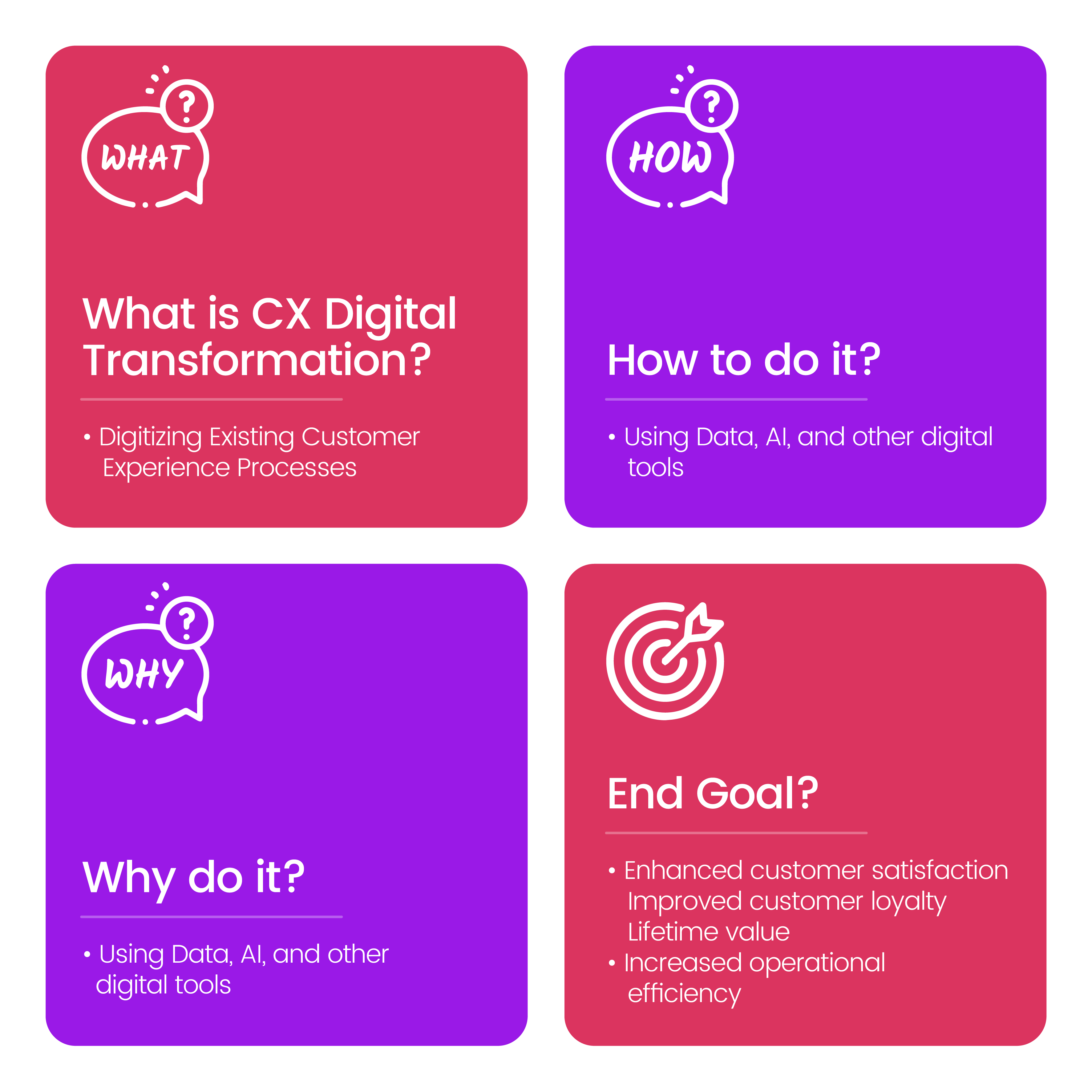
Companies who do great in customer experience drive revenues 4% to 8% higher compared to their competitors in the market.
In today’s very competitive business environment, customer experience has become a very key battleground. But the big question is how exactly should firms drive a real transformation in customer experience in this digital age?
Well, that lies in one very critical first step: customer journey mapping. Starting with journey map provides companies with:
- A structured perspective of the customers’ interaction with a brand
- Highlight blind spots
- Lead to eventual opportunities
If you consider customer journey mapping at the very top of your list, it will keep your digital transformation laser-focused on things that matter to your customers.
So, are you ready to unlock the secrets of CX transformation with journey mapping? Let’s dive in.
What is Customer Experience (CX) Digital Transformation?

Customer Experience (CX) Digital transformation simply means the deep transformation and enhancement of a company’s interaction with, and service for, its customers through the application of digital technologies.
The process includes reimagining customer touchpoints, process streamlining, and creating seamless and personalized experiences across channels.
Why is Customer Experience (CX) Digital Transformation Important?
CX digital transformation is important to every business for several reasons—let us discuss them one by one!
First and foremost, it keeps pace with the changing customer expectations, leading to hassle-free and personalized communications across any channel. Also, customers in the digital age look for convenience and ease, which can be easily served with CX transformation.
Second, CX digital transformation drives competitive advantage. Firms that prioritize and excel in digital CX effortlessly improve brand value, consequently attracting more customers within crowded markets. This, in turn, results in enhanced customer loyalty as well as higher lifetime value.
Third, it enhances operational efficiency like never before. Seamless and data-driven processes help businesses lower costs while raising service quality.
Last but certainly not least, CX transformation empowers companies to enact swift responses to change in the marketplace and with new technologies, hence securing long-term sustainability and growth in today’s digital world.
What is Customer Journey Mapping?
Customer Journey Mapping is a simple representation of the complete customer experience using a product or service. It details each series of interactions that a customer has with a brand, starting from the very stage of self-awareness to the last step of purchase and beyond.
The process typically involves mapping out different touchpoints where customers come into contact with the company via various channels, including websites, mobile apps, retail shops, and customer care. The thoughts, feelings, and pain points of customers are recorded at each step of the journey.
The phases of customer journey map usually include:
- Awareness
- Consideration
- Purchase
- Retention
- Advocacy
Building this end-to-end viewpoint allows companies to identify service gaps and take preventive steps to satisfy customer experiences.
Importance of Customer Journey Mapping in Customer Experience (CX)
Here are the top six reasons why customer journey mapping in customer experience is important:
Comprehensive View:
It provides a complete view, right from start to finish, of the entire customer experience, pain points and moments of delight.
Customer Friendly Decisions:
The journey mapping exercise forces an organization to look at its processes through the eyes of the customer, thereby encouraging empathy as well as customer-driven decisions along the way.
Finds Gaps:
It brings out the gaps between the targeted customer experience vs. the exact customer experience so that targeted improvements can be taken up.
Cross-Functional Alignment:
It helps in aligning various functions on common customer-centric goals, breaking silos.
Personalization Opportunities:
Journey maps identify those critical moments where personalization may have the greatest impact to improve customer experience.
Now that you know the importance of customer journey mapping, now let us explore why it must be your first step:
Pillar of the Strategy:
It provides the important context required to develop an effective CX strategy, ensuring all processes and operations are based on customer reality.
Consideration of Tools:
As we discussed earlier, customer journey mapping reveals the most important pain points and opportunities, thereby driving prioritization of CX strategies to gain maximum impact.
Cuts Down Irrelevant Investments:
If you start with customer journey mapping, there is less chance of you investing in unnecessary technologies or processes that would not address the problems of the existing customers.
Enables Persona Development:
Journey mapping refines and validates customer personas, which is, undoubtedly, the key to tailoring experience.
Shows Hidden Opportunities:
A comprehensive customer journey mapping can help you discover unexpected areas of innovation or differentiation that otherwise would be left hidden with any other approach.
Leverage the next-gen solutions for your digital customer experience
How to Conduct Customer Journey Mapping?
The customer journey map is a chronological process, and each step needs to be strategized. Having said that, here are the steps involved in effective customer journey mapping:
Define Objectives and Scope
First things first, be very clear about what you expect to achieve with your customer’s journey map. Are you aiming to improve customer retention, increase sales, or improve satisfaction of customers?
Having an idea of objectives and scope will help in keeping you focused.
Here’s how you can define objectives and scope:
- Document your goals
- Decide the segment of customers
- Decide the timeframe for journey
- Decide key metrics
- Decide stakeholders
- Choose the required resources
Identify Customer Personas
Create detailed personas for your typical customers by describing their demographic information, goals, challenges, preferences, and behavior. Rely on data from the interviews of customers, analytics, and surveys to create the most accurate representation. This will allow you to know what is important to your target personas and lets you understand any of your customer’s needs or expectations for every point in their journey.
Steps to examine and decide customer personas:
- Collect customers’ information
- Do customer interviews
- Closely check feedback of customers
- Make demographic profiles
- Make a list of needs and challenges of customers
- Validate personas from stakeholders
List Touchpoints and Channels
The third step is to find out channels through which customers interact with your brand: both online and offline touchpoints. It may be useful to consider every potential channel a customer could come into contact, from initial awareness to after-purchase support. Make this list exhaustive so you do not miss out on important interactions on your journey map.
Common channels and touchpoints you can consider:
- Mobile applications
- Chatbots
- Website
- Email marketing
- Television commercials
- Social media platforms
Map the Current Customer Journey
Map your customer journey with a visual representation of the steps that your customer often takes to connect with your brand, starting with the first contact and ending with the last one. Include actions, thoughts, emotions, and potential pain points that the customers might experience. It should be based on real customer data and feedback, not on assumptions.
Effective steps to map the customer journey:
- Figure out major stages
- Plot actions of customers
- Note down emotions and opinions of customers
- Include timeframes
- Mention moments of truth
- Include backend processes
- Prioritize customer feedback
- Utilize visual elements
Analyze Pain Points and Opportunities
Lastly, go through your customer journey map once again, and you’ll be able to point out areas where you’ve identified struggling customers or dissatisfaction. These key zones represent opportunities for improvement and, at the same time, represent key areas where you are able to meet customer expectations. This analysis will really help you in looking at priorities in areas of enhancement and innovation in your customer experience strategy.
How to identify hidden pain points and opportunities?
- Do customer surveys
- Check customer data
- Check social media customer engagement
- Do competitor analysis
- Analyze customer behavioral patterns
How JindalX Helped a World’s Leading Classified Platform with Customer Journey Mapping?
JindalX partnered with a world-leading classified platform to enhance their customer experience through an elaborative customer journey mapping.
To begin with, JindalX mapped out the customer journey across the classified platform and compared it with various competitors to find several key bottlenecks and improvement opportunities.
This collaboration allowed the team to zero in on the most pervasive problems affecting customer satisfaction and derive solutions accordingly. The results were impressive, as the platform did much better on several metrics.
User registration rates increased, time spent on the platform grew, and seller satisfaction saw a substantial lift. The project brought about visible growth in conversion rates, increased customer satisfaction scores, and notable growth in market share.
This story goes on to further strengthen the fact that JindalX is able to turn customer journey insights into tangible business outcomes for its clients.
5 Key Trends Fueling Digital Transformation of the Customer Experience
Now that you know everything about customer experience digital transformation and customer journey mapping, let us quickly have a look at the top five trends that is enabling it in the present time:
Hyper-Personalization
Personalization was the past. Today, it is the era of hyper-personalization because users now expect a company to deliver supremely personalized experiences. To meet this need, companies are making the most of customer data and building extensive customer profiles. An example of such hyper-personalization is Starbucks, in which its mobile app incorporates personal recommendations in relation to their previous purchases and preferences. Proper use of customer data makes it easier for Starbucks to enhance their customers’ engagement and loyalty.
Omnichannel Engagement
From online and in-store to mobile devices, customers are increasingly utilizing different channels over the course of their journey. To stay ahead of this trend, companies need to align and harmonize online and offline channels to provide a coherent, unified brand experience. Nike is one of the most relevant examples. The company has really nailed their omni-channel integration that has eventually helped them to ensure seamless experience across every channel.
Real-Time Feedback
Real-time customer feedback is also becoming more vital than ever before. It is, undoubtedly, enabling continuous improvements to keep customers satisfied. Meeting these expectations requires the firms to collect, analyze, and act upon real-time customer feedback. This calls for having strong feedback mechanisms, real-time data analytics, and agile modulations based on customer insights.
A great example is the company Airbnb, which subtly incorporates feedback from its guests. As a result, Airbnb is fast to solve problems and constantly improves its offerings based on customers’ feedback, nurturing loyalty and trust towards the brand.
Mobile and Social Media Channels and Technologies
Social media, smartphones, and mobile technology have been digitizing the experience of customers. Customer involvement/agreement is now channeled through in-app and SMS messaging, social media channels, and online review platforms. All these technologies are here to stay. So, businesses must advertise their value propositions, prioritize mobile and social media channels to understand the pulse of the customers, and be present everywhere.
Artificial Intelligence and Machine Learning
In recent years, with the increase in AI and machine learning, digitization has gone several notches higher. Savvy brands are further pushing AI into the customer experience in order to know more about their customers, provide faster resolutions, and bring speed to the analysis for a personalized experience.
Now, chatbots and virtual assistants fueled by AI are seen commonly in websites and apps, giving instant support to customers. These technologies have also allowed businesses to automate numerous aspects of the customer journey, including personalized product recommendation and predictive customer service.
Parting Thoughts
Analyzing and optimizing the customer journey is more critical than ever in today’s fast-moving digital landscape. Customer journey mapping empowers businesses to gain valuable insights into their customers’ needs, preferences, and pain points. It could bring companies closer to creating personalized, seamless, and satisfying experiences across all touchpoints.
When it comes to customer journey mapping, a proper design of plans, collection, and analysis of data will be needed. Getting this right may provide one with the visibility into hidden opportunities for improvement and innovation that will ensure enhanced customer satisfaction, loyalty, and growth of a business.
Always remember customer journey mapping and digital transformation are continuous processes, not one-time activity. As customer behaviors and technologies continue to evolve, so must your approaches toward better understanding and enhancing the customer experience. Only with such commitment to continuous improvement can businesses establish long-term relationships with their customers and truly succeed in the digital age.







